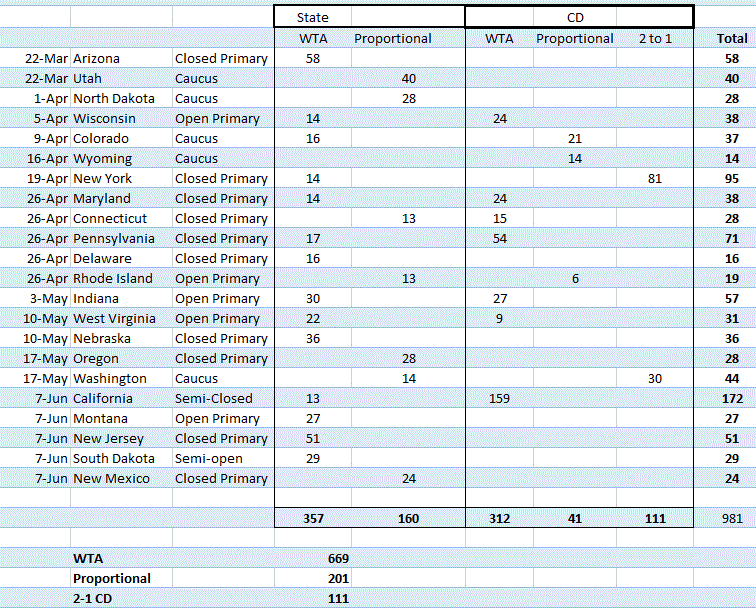Another revealing look at the battle for the Republican nomination. Click here to read fladem’s earlier analysis of the GOP delegate race. -promoted by desmoinesdem
Before Super Tuesday I wrote a piece here suggesting that the talk in the aftermath of those contests would be a brokered convention. That was right, I think. In fact, if you look at the delegate math today, Trump is actually further from a majority than he was before Super Tuesday. As an aside, a real time delegate projection is here.
But politics is not just measured in delegates won.
A week ago Trump won Kentucky and Louisiana, and the talk once against has suggested he is unlikely to be stopped. There are good reasons for arguing Trump’s position is much stronger now than it was the day after Super Tuesday. The biggest of these reasons is the unexpected collapse of Marco Rubio. Rubio’s collapse has left little doubt that Trump will win Florida and its 99 delegates. Equally important, Trump’s win in Michigan denied John Kasich momentum that might not only have propelled him to victory in Ohio, but could also have made him a threat in Illinois and Missouri.
In politics we often talk of the narrative. The narrative is not about delegate math, it is about momentum. It asks who is winning and why. It is unforgiving: you either win or you lose. It is difficult to lose and maintain any semblance of energy in a campaign (something seen in Rubio’s implosion) but it also means no more money for future primaries.
In any primary fight, there are times when these two forces are at odds. Such is the case now.
The table below shows five scenarios for today (given that about 35% of Florida’s vote has already been cast, and Trump has maintained a double digit lead throughout, it seems difficult to believe he can lose Florida).

I want to focus on the column to the far right. In virtually all of the scenarios, Trump will need to win more than half of the remaining delegates. Should Kasich win Ohio and Trump everywhere else, Trump will still need to win over 54% of the remaining delegates. From a delegate math perspective, in virtually every scenario I have run he still will need over half of the remaining delegates.
And here is where math will collide with the narrative. If Kasich loses Ohio, we are likely to very quickly find ourselves in a 1 on 1 contest. Because of the delegate allocation rules, which greatly magnify even 5 point wins, the narrative will matter more than the math. Cruz will leave tomorrow with one win at best likely. But he will be in a one on one race with Trump: and polling suggests he is likely to win the fight.
Conversely, if Kasich wins, the probability of a brokered convention grows, both because of the schedule and the math. To understand why lets look at the following hypothetical. As you can see, even though Trump’s popular vote lead is larger in the three way example, he nets only 87 of 201 delegates, less than a majority. Conversely, in a two way race he wins more than a majority.

One thing I am convinced little thought has been given to is the delegate rules in the remaining contests. As it shows, the vast majority of the remaining delegates are winner take all, either at the state level or the CD level. If a candidate wins a state by more than 7, they are likely to win all but a handful of delegates even in large states like California.
Two lessons to draw from his chart:
1. The narrative may overwhelm the math. If a candidate is able to win multiple states in a row, it is likely that he will generate a momentum that will lead him to win the majority of states. It is in fact possible for Ted Cruz, if he became the de facto establishment candidate, to win over 1,000 delegates. Primary fights frequently end when an acknowledged consensus within the party is reached. It is easy to envision Kasich, Trump or Cruz to become that candidate.
2. The race is in some ways set-up for a split. Cruz has done well in caucuses to date: he likely to do well in the four caucuses before April 19th. Conversely, it would be relatively easy to see Kasich, who has done best in Northern states, to be Trump’s biggest competition in Wisconsin, New York and the states of April 26th.

Historically brokered conventions were a product of regional candidates. In the race to date, we have seen some of that. But as you look at the calendar it becomes clear that stopping Trump means beating him in states where Cruz has shown little appeal to date. Should Kasich lose Ohio, the stop Trump forces may have run out of candidates, even though the math may be against Trump.


No Comments